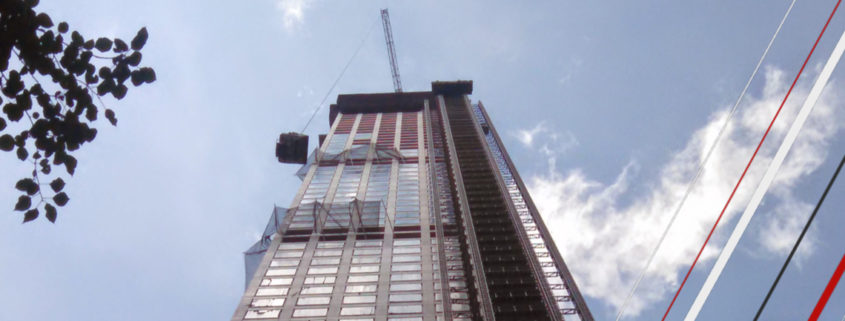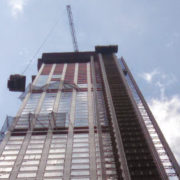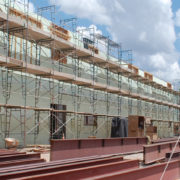Combustible cladding could be banned in the wake of Glenfell
Prime minister Theresa May has given another indication that the government is set to ban combustible cladding on high-rise buildings.
The government has already placed the possibility of such a ban under review, with housing secretary James Brokenshire announcing the move just hours after the publication last week of the Hackitt
Review, which stopped short of recommending a ban.
Brokenshire had already said in Parliament that the government was likely to agree a ban.
Now May has also admitted that she is “minded” to put a ban into action.
At prime minister’s questions yesterday, she confirmed that a ban was the government’s intention.
She said: “We are minded to go further, by banning combustible materials in cladding on high-rise buildings.
“We are meeting our legal duties to consult on these proposals and we will not delay any necessary action.”
She was responding to a question by Conservative MP Nigel Huddleston, who urged the prime minister to take tougher action to ban flammable cladding to avoid another tragedy like Grenfell Tower.
Following the publication last week of Dame Judith Hackitt’s final report into her review of Building Regulations and fire safety, the report’s eight key recommendations are as follows:
1) New regulatory framework
A new regulatory framework for buildings more than ten storeys high. This includes the creation of a new Joint Competent Authority (JCA), made up of Local Authority Building Standards, fire and rescue authorities and the Health and Safety Executive. The JCA will hold a database of all high-risk residential buildings (HHRBs), whether in construction or already occupied. It will oversee the sign-off of HHRBs with dutyholders having to show that their plans are “detailed and robust”.
2) Clear responsibilities
Hackitt warned that a lack of clarity on roles and responsibilities when it comes to building safety was one of the circumstances that left to the Grenfell Tower disaster. She is recommending a clear and identifiable “dutyholder” with responsibility for building safety for the whole building. That dutyholder will have to present a safety case to the JCA at regular intervals. The key roles that are most important initiating, overseeing and influencing activity throughout the procurement, design and construction of a building should also be identified. The key roles for prioritising building safety will be the same as those identified in the Construction Design and Management (CDM) Regulations 2015 to avoid confusion.
3) Three ‘gateways’
There should be three “gateway” points where those responsible for a building’s safety will have to prove to the new JCA that they are complying with regulations. The first gateway point is to satisfy the JCA that the building is accessible by the fire service, which must be determined before the building gets planning permission. Secondly, the dutyholder must satisfy the JCA that key building safety risks are understood and will be managed and that “robust” processes are in place, before building work can start. Thirdly, the JCA must be satisfied that the signed-off design has been followed before occupation can start.
4) More rigorous enforcement
More rigorous enforcement powers. A wider and more flexible range of powers will be created to focus incentives on the creation of reliably safe buildings from the outset. Stronger enforcement powers should align with the Health and Safety at Work Act. The JCA/Local Authority Building Standards should have additional powers to issue improvement and prohibition notices, as well as clear powers to require changes to work that meet Building Regulations. Time limits for bringing prosecutions should be increased to five or six years for “major deficiencies”.
5) Higher competence levels
The construction sector and fire safety sector will have to demonstrate more effective leadership for ensuring building safety among key roles including an overarching body to provide oversight of competence requirements. The aim is to move towards a system where ownership of technical guidance rests with the industry as the intelligent lead in delivering building safety and providing it with the flexibility to ensure that guidance keeps pace with changing practices.
6) More effective product testing
A clearer, more transparent and more effective specification and testing regime of construction products must be developed, including products as they are put together as part of a system. There should be clear statements on what systems products can and cannot be used for, with their use made essential. The scope of testing, the application of products in systems, and the resulting implications must be more clearly communicated in plan, consistent and non-technical information. Additional test houses should be established and certified, while test methods and standards should be maintained under a periodic review process.
7) Better information
The review has identified four “key information products” integral to oversight on building safety. They are: the digital record, the fire and emergency file, full plans, and the construction control plan. Hackitt recommends that the creation, maintenance and handover of relevant information should be an “integral part” of the legal responsibilities of clients, principal designers, and principal contractors undertaking works on HRRBs.
8) Better procurement
Principal contractors and clients for HHRBs should devise contracts that specifically state that safety requirements must not be compromised for cost reduction. Tenders should set out how the proposed solution will produce safe building outcomes. Contracting documentation relating to the safety aspects of the building should be included in the digital record.
MPs are set to explore how systemic and cultural changes recommended as part of the Hackitt Review can be applied to the the construction industry as a whole.
The exercise comes as part of the Housing, Communities and Local Government Committee’s decision to follow up its work on the recent independent review of Building regulations and fire safety by holding further evidence sessions.
The sessions will examine the immediate changes needed to improve the safety of high-rise residential tower blocks, as well as some of the longer-term implications for the construction industry as a whole.
The Committee will call representatives including figures from the construction industry and fire safety experts, as well as the government, before Parliament breaks up for the summer recess.
It said it wanted to explore immediate, specific changes to regulations needed to make tower blocks safe, as well as how the longer-term systemic and cultural changes the Hackitt Review proposes can be implemented and how they apply to the construction industry more widely.
Clive Betts, chair of the Committee, said: “While we agree with the Review that there needs to be a shift in culture in the building industry, it is vital that the Government moves quickly to implement immediate changes to improve the safety of tower blocks.
“We want to find out what needs to be done now, such as the banning of combustible cladding, as well as ways of changing the long-term approach of the industry.
“By taking evidence before the summer we hope the government will consider our findings as part of the commitments made by the secretary of state last week to consult on banning cladding and the implementation of wider reform of the regulatory system.”
Source: Construction Manager Magazine / UK Construction Week









Leave a Reply
Want to join the discussion?Feel free to contribute!